Management Accounting Report: Costing, Budgeting & Variance Analysis
VerifiedAdded on 2023/06/18
|19
|4234
|466
Report
AI Summary
This management accounting report provides a comprehensive analysis of Plaistead Plc and Crawford Plc, covering various aspects of costing, budgeting, and variance analysis. It includes calculations for contribution per unit, break-even sales revenue, margin of safety, and profit estimation for Plaistead Plc under different scenarios. The report also explores the impact of adopting a new pricing strategy. For Crawford Plc, the report details the allocation of costs to different departments using appropriate ratios and calculates overhead recovery rates. Furthermore, it determines the full job cost and product cost for a special product. Finally, the report discusses the estimations of budgets and variances for Jayrod Plc's PK65 product, offering insights into management accounting principles and their practical application. Desklib provides access to this and many other solved assignments to help students.

Introduction to
management accounting
management accounting
Paraphrase This Document
Need a fresh take? Get an instant paraphrase of this document with our AI Paraphraser
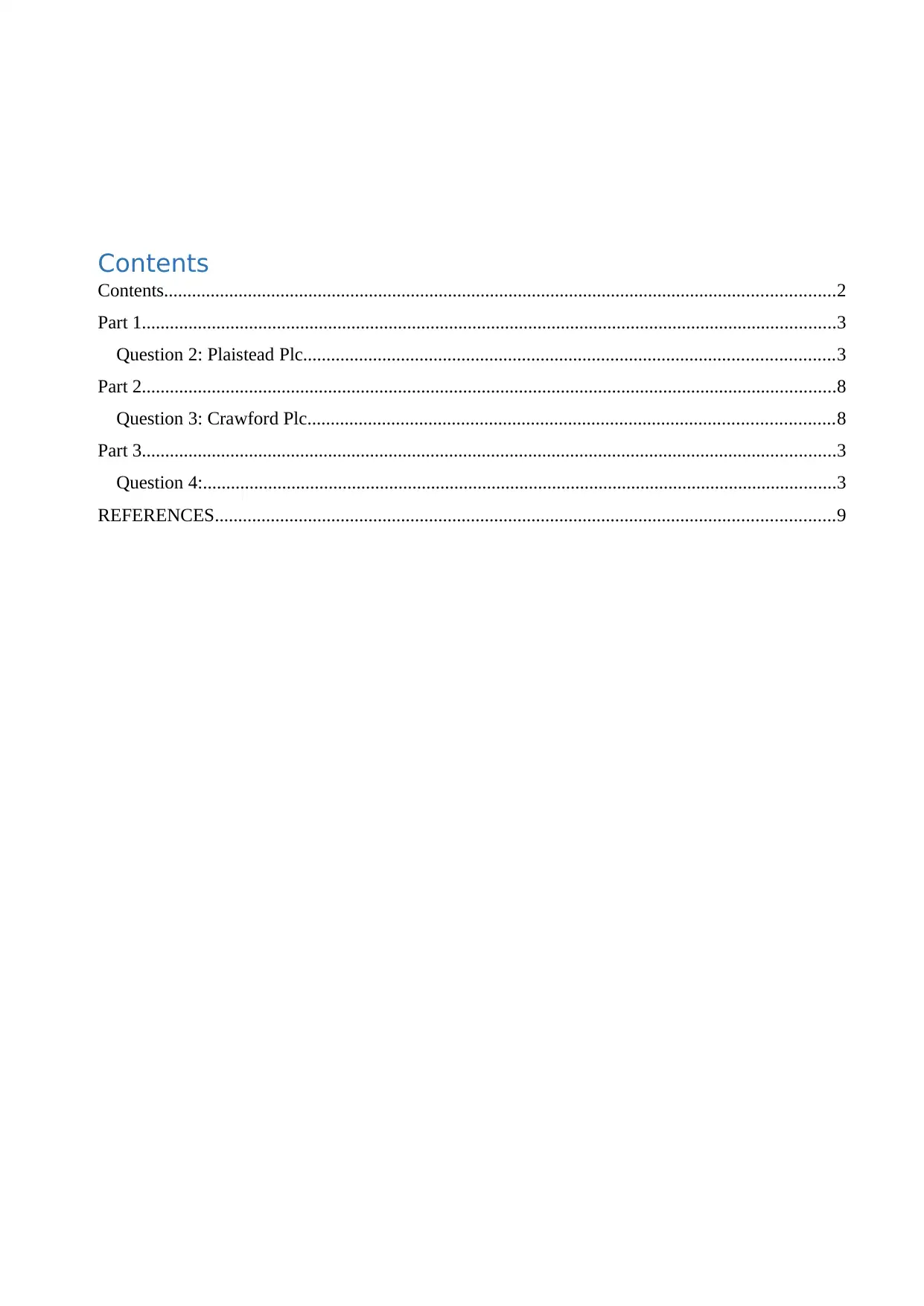
Contents
Contents................................................................................................................................................2
Part 1.....................................................................................................................................................3
Question 2: Plaistead Plc..................................................................................................................3
Part 2.....................................................................................................................................................8
Question 3: Crawford Plc.................................................................................................................8
Part 3.....................................................................................................................................................3
Question 4:........................................................................................................................................3
REFERENCES.....................................................................................................................................9
Contents................................................................................................................................................2
Part 1.....................................................................................................................................................3
Question 2: Plaistead Plc..................................................................................................................3
Part 2.....................................................................................................................................................8
Question 3: Crawford Plc.................................................................................................................8
Part 3.....................................................................................................................................................3
Question 4:........................................................................................................................................3
REFERENCES.....................................................................................................................................9
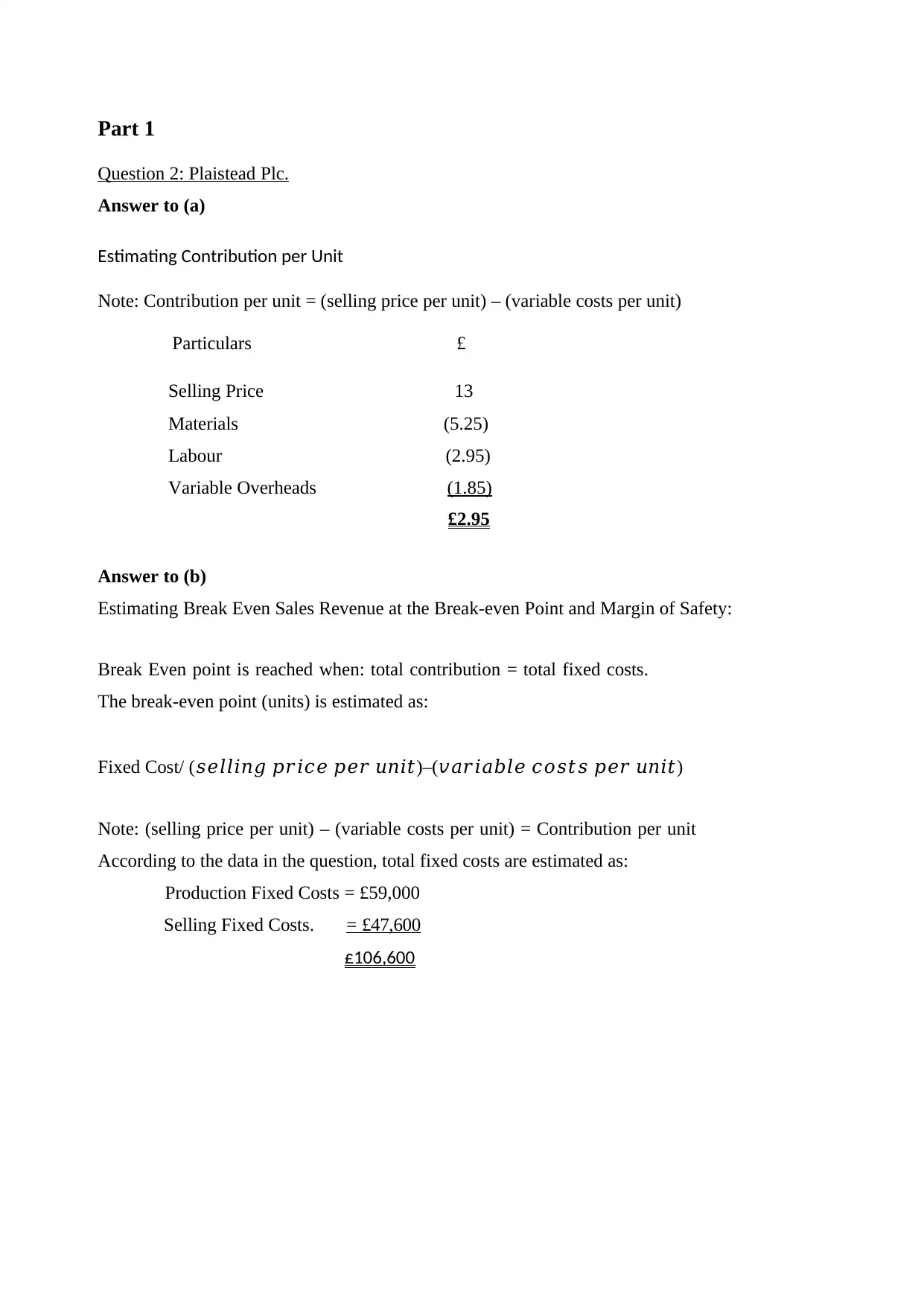
Part 1
Question 2: Plaistead Plc.
Answer to (a)
Estimating Contribution per Unit
Note: Contribution per unit = (selling price per unit) – (variable costs per unit)
Particulars £
Selling Price 13
Materials (5.25)
Labour (2.95)
Variable Overheads (1.85)
£2.95
Answer to (b)
Estimating Break Even Sales Revenue at the Break-even Point and Margin of Safety:
Break Even point is reached when: total contribution = total fixed costs.
The break-even point (units) is estimated as:
Fixed Cost/ (𝑠𝑒𝑙𝑙𝑖𝑛𝑔 𝑝𝑟𝑖𝑐𝑒 𝑝𝑒𝑟 𝑢𝑛𝑖𝑡)–(𝑣𝑎𝑟𝑖𝑎𝑏𝑙𝑒 𝑐𝑜𝑠𝑡𝑠 𝑝𝑒𝑟 𝑢𝑛𝑖𝑡)
Note: (selling price per unit) – (variable costs per unit) = Contribution per unit
According to the data in the question, total fixed costs are estimated as:
Production Fixed Costs = £59,000
Selling Fixed Costs. = £47,600
£106,600
Question 2: Plaistead Plc.
Answer to (a)
Estimating Contribution per Unit
Note: Contribution per unit = (selling price per unit) – (variable costs per unit)
Particulars £
Selling Price 13
Materials (5.25)
Labour (2.95)
Variable Overheads (1.85)
£2.95
Answer to (b)
Estimating Break Even Sales Revenue at the Break-even Point and Margin of Safety:
Break Even point is reached when: total contribution = total fixed costs.
The break-even point (units) is estimated as:
Fixed Cost/ (𝑠𝑒𝑙𝑙𝑖𝑛𝑔 𝑝𝑟𝑖𝑐𝑒 𝑝𝑒𝑟 𝑢𝑛𝑖𝑡)–(𝑣𝑎𝑟𝑖𝑎𝑏𝑙𝑒 𝑐𝑜𝑠𝑡𝑠 𝑝𝑒𝑟 𝑢𝑛𝑖𝑡)
Note: (selling price per unit) – (variable costs per unit) = Contribution per unit
According to the data in the question, total fixed costs are estimated as:
Production Fixed Costs = £59,000
Selling Fixed Costs. = £47,600
£106,600
⊘ This is a preview!⊘
Do you want full access?
Subscribe today to unlock all pages.

Trusted by 1+ million students worldwide
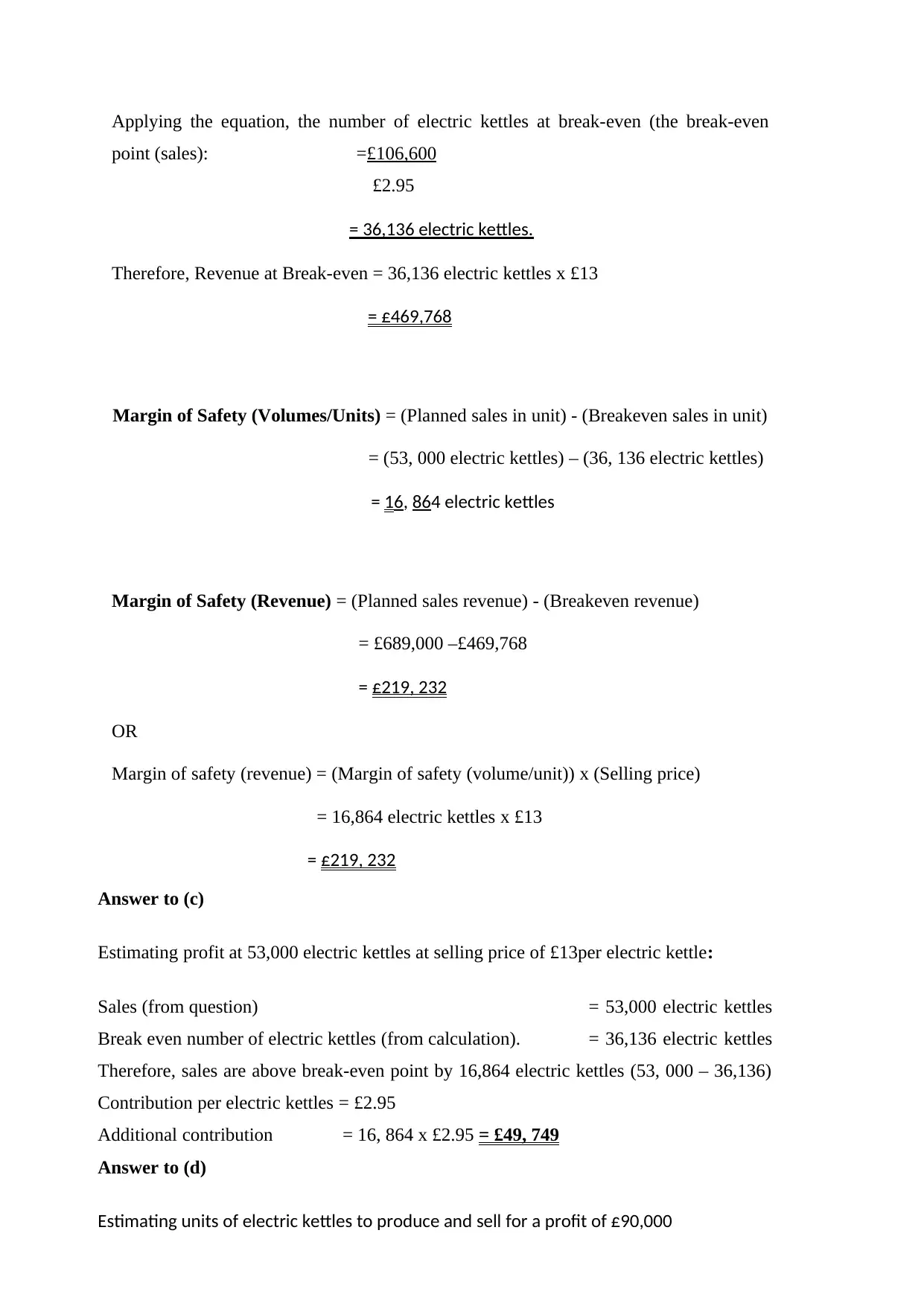
Applying the equation, the number of electric kettles at break-even (the break-even
point (sales): =£106,600
£2.95
= 36,136 electric kettles.
Therefore, Revenue at Break-even = 36,136 electric kettles x £13
= £469,768
Margin of Safety (Volumes/Units) = (Planned sales in unit) - (Breakeven sales in unit)
= (53, 000 electric kettles) – (36, 136 electric kettles)
= 16, 864 electric kettles
Margin of Safety (Revenue) = (Planned sales revenue) - (Breakeven revenue)
= £689,000 –£469,768
= £219, 232
OR
Margin of safety (revenue) = (Margin of safety (volume/unit)) x (Selling price)
= 16,864 electric kettles x £13
= £219, 232
Answer to (c)
Estimating profit at 53,000 electric kettles at selling price of £13per electric kettle:
Sales (from question) = 53,000 electric kettles
Break even number of electric kettles (from calculation). = 36,136 electric kettles
Therefore, sales are above break-even point by 16,864 electric kettles (53, 000 – 36,136)
Contribution per electric kettles = £2.95
Additional contribution = 16, 864 x £2.95 = £49, 749
Answer to (d)
Estimating units of electric kettles to produce and sell for a profit of £90,000
point (sales): =£106,600
£2.95
= 36,136 electric kettles.
Therefore, Revenue at Break-even = 36,136 electric kettles x £13
= £469,768
Margin of Safety (Volumes/Units) = (Planned sales in unit) - (Breakeven sales in unit)
= (53, 000 electric kettles) – (36, 136 electric kettles)
= 16, 864 electric kettles
Margin of Safety (Revenue) = (Planned sales revenue) - (Breakeven revenue)
= £689,000 –£469,768
= £219, 232
OR
Margin of safety (revenue) = (Margin of safety (volume/unit)) x (Selling price)
= 16,864 electric kettles x £13
= £219, 232
Answer to (c)
Estimating profit at 53,000 electric kettles at selling price of £13per electric kettle:
Sales (from question) = 53,000 electric kettles
Break even number of electric kettles (from calculation). = 36,136 electric kettles
Therefore, sales are above break-even point by 16,864 electric kettles (53, 000 – 36,136)
Contribution per electric kettles = £2.95
Additional contribution = 16, 864 x £2.95 = £49, 749
Answer to (d)
Estimating units of electric kettles to produce and sell for a profit of £90,000
Paraphrase This Document
Need a fresh take? Get an instant paraphrase of this document with our AI Paraphraser
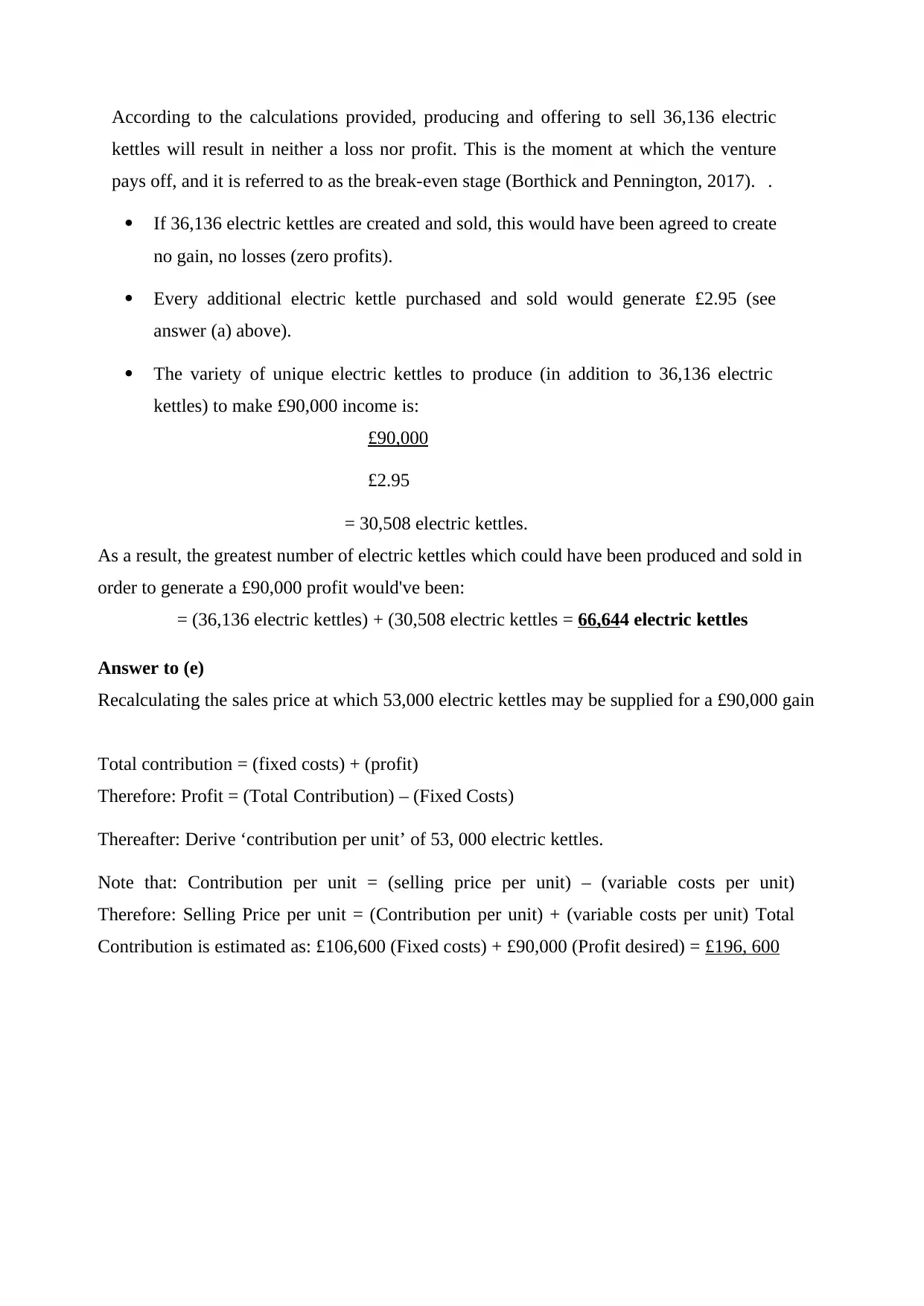
According to the calculations provided, producing and offering to sell 36,136 electric
kettles will result in neither a loss nor profit. This is the moment at which the venture
pays off, and it is referred to as the break-even stage (Borthick and Pennington, 2017). .
If 36,136 electric kettles are created and sold, this would have been agreed to create
no gain, no losses (zero profits).
Every additional electric kettle purchased and sold would generate £2.95 (see
answer (a) above).
The variety of unique electric kettles to produce (in addition to 36,136 electric
kettles) to make £90,000 income is:
£90,000
£2.95
= 30,508 electric kettles.
As a result, the greatest number of electric kettles which could have been produced and sold in
order to generate a £90,000 profit would've been:
= (36,136 electric kettles) + (30,508 electric kettles = 66,644 electric kettles
Answer to (e)
Recalculating the sales price at which 53,000 electric kettles may be supplied for a £90,000 gain
Total contribution = (fixed costs) + (profit)
Therefore: Profit = (Total Contribution) – (Fixed Costs)
Thereafter: Derive ‘contribution per unit’ of 53, 000 electric kettles.
Note that: Contribution per unit = (selling price per unit) – (variable costs per unit)
Therefore: Selling Price per unit = (Contribution per unit) + (variable costs per unit) Total
Contribution is estimated as: £106,600 (Fixed costs) + £90,000 (Profit desired) = £196, 600
kettles will result in neither a loss nor profit. This is the moment at which the venture
pays off, and it is referred to as the break-even stage (Borthick and Pennington, 2017). .
If 36,136 electric kettles are created and sold, this would have been agreed to create
no gain, no losses (zero profits).
Every additional electric kettle purchased and sold would generate £2.95 (see
answer (a) above).
The variety of unique electric kettles to produce (in addition to 36,136 electric
kettles) to make £90,000 income is:
£90,000
£2.95
= 30,508 electric kettles.
As a result, the greatest number of electric kettles which could have been produced and sold in
order to generate a £90,000 profit would've been:
= (36,136 electric kettles) + (30,508 electric kettles = 66,644 electric kettles
Answer to (e)
Recalculating the sales price at which 53,000 electric kettles may be supplied for a £90,000 gain
Total contribution = (fixed costs) + (profit)
Therefore: Profit = (Total Contribution) – (Fixed Costs)
Thereafter: Derive ‘contribution per unit’ of 53, 000 electric kettles.
Note that: Contribution per unit = (selling price per unit) – (variable costs per unit)
Therefore: Selling Price per unit = (Contribution per unit) + (variable costs per unit) Total
Contribution is estimated as: £106,600 (Fixed costs) + £90,000 (Profit desired) = £196, 600
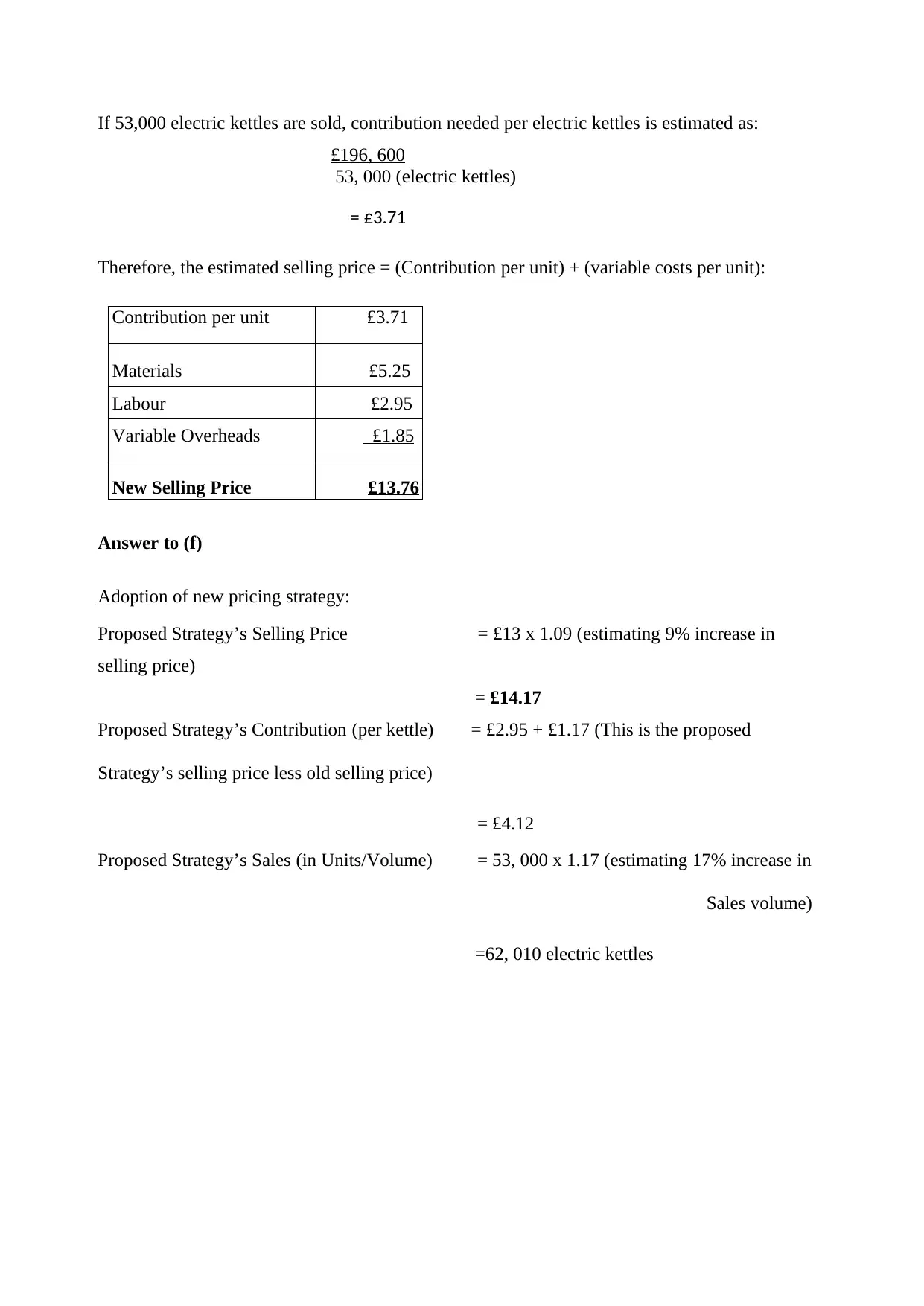
If 53,000 electric kettles are sold, contribution needed per electric kettles is estimated as:
£196, 600
53, 000 (electric kettles)
= £3.71
Therefore, the estimated selling price = (Contribution per unit) + (variable costs per unit):
Contribution per unit £3.71
Materials £5.25
Labour £2.95
Variable Overheads £1.85
New Selling Price £13.76
Answer to (f)
Adoption of new pricing strategy:
Proposed Strategy’s Selling Price = £13 x 1.09 (estimating 9% increase in
selling price)
= £14.17
Proposed Strategy’s Contribution (per kettle) = £2.95 + £1.17 (This is the proposed
Strategy’s selling price less old selling price)
= £4.12
Proposed Strategy’s Sales (in Units/Volume) = 53, 000 x 1.17 (estimating 17% increase in
Sales volume)
=62, 010 electric kettles
£196, 600
53, 000 (electric kettles)
= £3.71
Therefore, the estimated selling price = (Contribution per unit) + (variable costs per unit):
Contribution per unit £3.71
Materials £5.25
Labour £2.95
Variable Overheads £1.85
New Selling Price £13.76
Answer to (f)
Adoption of new pricing strategy:
Proposed Strategy’s Selling Price = £13 x 1.09 (estimating 9% increase in
selling price)
= £14.17
Proposed Strategy’s Contribution (per kettle) = £2.95 + £1.17 (This is the proposed
Strategy’s selling price less old selling price)
= £4.12
Proposed Strategy’s Sales (in Units/Volume) = 53, 000 x 1.17 (estimating 17% increase in
Sales volume)
=62, 010 electric kettles
⊘ This is a preview!⊘
Do you want full access?
Subscribe today to unlock all pages.

Trusted by 1+ million students worldwide
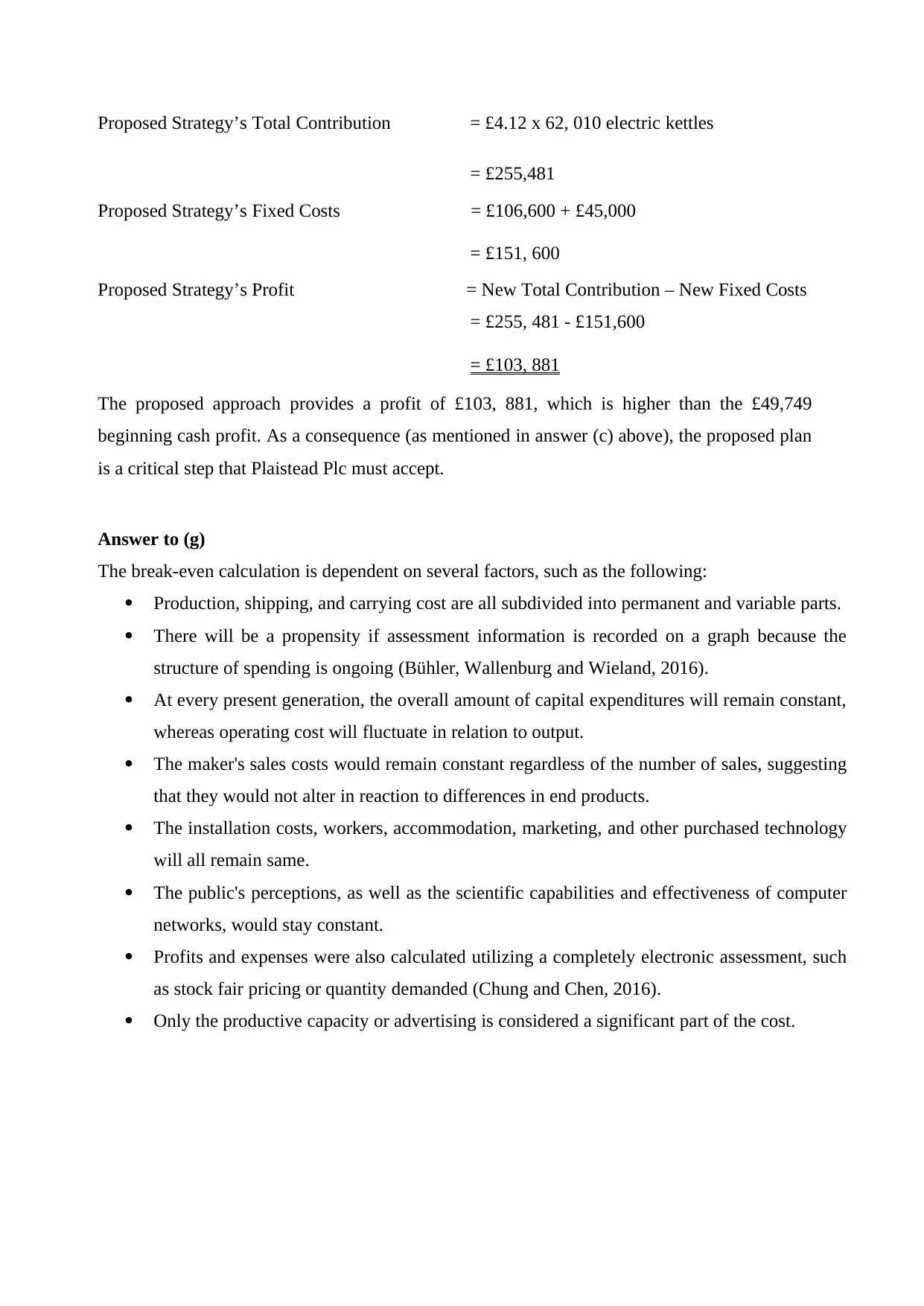
Proposed Strategy’s Total Contribution = £4.12 x 62, 010 electric kettles
= £255,481
Proposed Strategy’s Fixed Costs = £106,600 + £45,000
= £151, 600
Proposed Strategy’s Profit = New Total Contribution – New Fixed Costs
= £255, 481 - £151,600
= £103, 881
The proposed approach provides a profit of £103, 881, which is higher than the £49,749
beginning cash profit. As a consequence (as mentioned in answer (c) above), the proposed plan
is a critical step that Plaistead Plc must accept.
Answer to (g)
The break-even calculation is dependent on several factors, such as the following:
Production, shipping, and carrying cost are all subdivided into permanent and variable parts.
There will be a propensity if assessment information is recorded on a graph because the
structure of spending is ongoing (Bühler, Wallenburg and Wieland, 2016).
At every present generation, the overall amount of capital expenditures will remain constant,
whereas operating cost will fluctuate in relation to output.
The maker's sales costs would remain constant regardless of the number of sales, suggesting
that they would not alter in reaction to differences in end products.
The installation costs, workers, accommodation, marketing, and other purchased technology
will all remain same.
The public's perceptions, as well as the scientific capabilities and effectiveness of computer
networks, would stay constant.
Profits and expenses were also calculated utilizing a completely electronic assessment, such
as stock fair pricing or quantity demanded (Chung and Chen, 2016).
Only the productive capacity or advertising is considered a significant part of the cost.
= £255,481
Proposed Strategy’s Fixed Costs = £106,600 + £45,000
= £151, 600
Proposed Strategy’s Profit = New Total Contribution – New Fixed Costs
= £255, 481 - £151,600
= £103, 881
The proposed approach provides a profit of £103, 881, which is higher than the £49,749
beginning cash profit. As a consequence (as mentioned in answer (c) above), the proposed plan
is a critical step that Plaistead Plc must accept.
Answer to (g)
The break-even calculation is dependent on several factors, such as the following:
Production, shipping, and carrying cost are all subdivided into permanent and variable parts.
There will be a propensity if assessment information is recorded on a graph because the
structure of spending is ongoing (Bühler, Wallenburg and Wieland, 2016).
At every present generation, the overall amount of capital expenditures will remain constant,
whereas operating cost will fluctuate in relation to output.
The maker's sales costs would remain constant regardless of the number of sales, suggesting
that they would not alter in reaction to differences in end products.
The installation costs, workers, accommodation, marketing, and other purchased technology
will all remain same.
The public's perceptions, as well as the scientific capabilities and effectiveness of computer
networks, would stay constant.
Profits and expenses were also calculated utilizing a completely electronic assessment, such
as stock fair pricing or quantity demanded (Chung and Chen, 2016).
Only the productive capacity or advertising is considered a significant part of the cost.
Paraphrase This Document
Need a fresh take? Get an instant paraphrase of this document with our AI Paraphraser
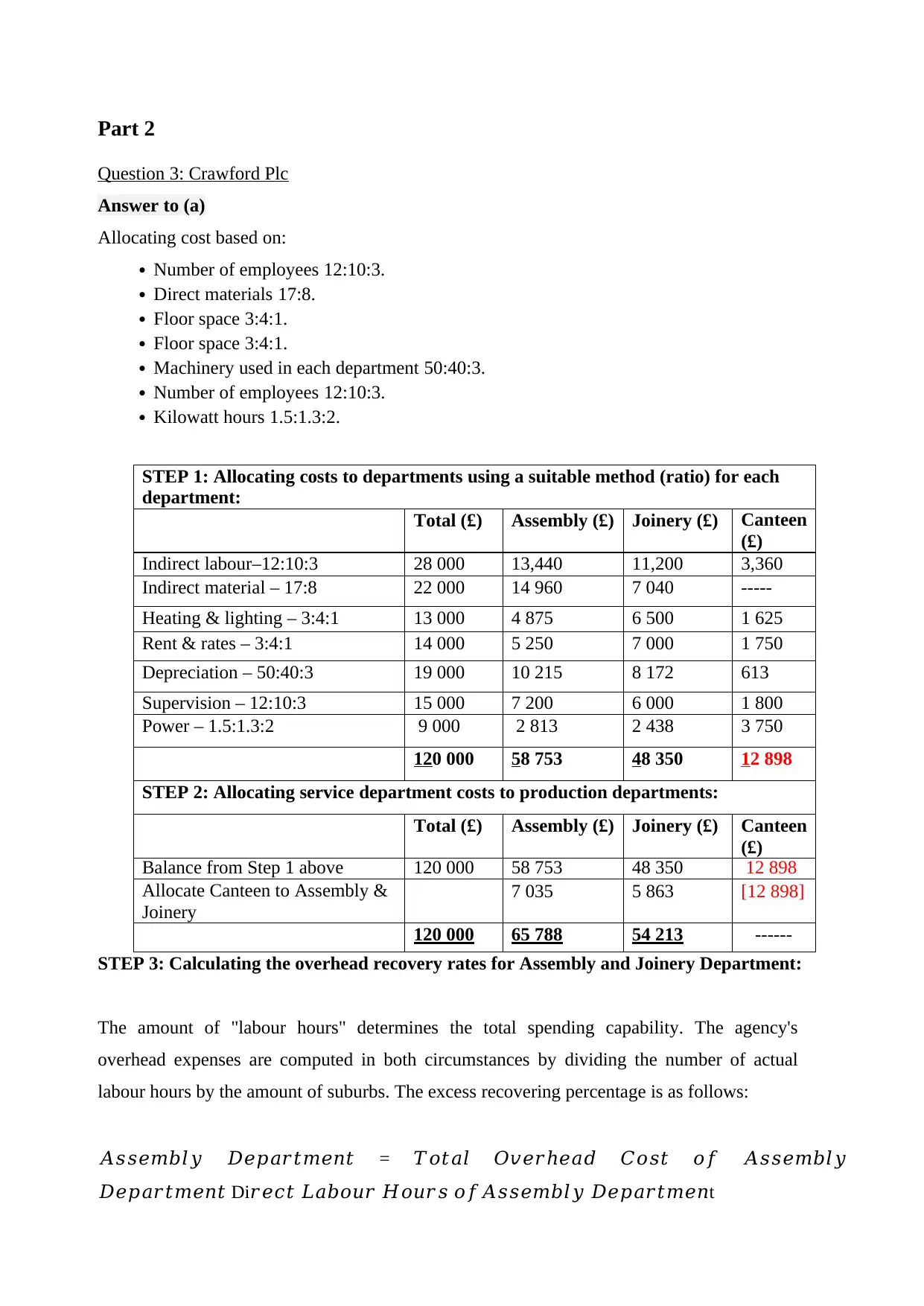
Part 2
Question 3: Crawford Plc
Answer to (a)
Allocating cost based on:
Number of employees 12:10:3.
Direct materials 17:8.
Floor space 3:4:1.
Floor space 3:4:1.
Machinery used in each department 50:40:3.
Number of employees 12:10:3.
Kilowatt hours 1.5:1.3:2.
STEP 1: Allocating costs to departments using a suitable method (ratio) for each
department:
Total (£) Assembly (£) Joinery (£) Canteen
(£)
Indirect labour–12:10:3 28 000 13,440 11,200 3,360
Indirect material – 17:8 22 000 14 960 7 040 -----
Heating & lighting – 3:4:1 13 000 4 875 6 500 1 625
Rent & rates – 3:4:1 14 000 5 250 7 000 1 750
Depreciation – 50:40:3 19 000 10 215 8 172 613
Supervision – 12:10:3 15 000 7 200 6 000 1 800
Power – 1.5:1.3:2 9 000 2 813 2 438 3 750
120 000 58 753 48 350 12 898
STEP 2: Allocating service department costs to production departments:
Total (£) Assembly (£) Joinery (£) Canteen
(£)
Balance from Step 1 above 120 000 58 753 48 350 12 898
Allocate Canteen to Assembly &
Joinery
7 035 5 863 [12 898]
120 000 65 788 54 213 ------
STEP 3: Calculating the overhead recovery rates for Assembly and Joinery Department:
The amount of "labour hours" determines the total spending capability. The agency's
overhead expenses are computed in both circumstances by dividing the number of actual
labour hours by the amount of suburbs. The excess recovering percentage is as follows:
𝐴𝑠𝑠𝑒𝑚𝑏𝑙𝑦 𝐷𝑒𝑝𝑎𝑟𝑡𝑚𝑒𝑛𝑡 = 𝑇𝑜𝑡𝑎𝑙 𝑂𝑣𝑒𝑟ℎ𝑒𝑎𝑑 𝐶𝑜𝑠𝑡 𝑜𝑓 𝐴𝑠𝑠𝑒𝑚𝑏𝑙𝑦
𝐷𝑒𝑝𝑎𝑟𝑡𝑚𝑒𝑛𝑡 Di𝑟𝑒𝑐𝑡 𝐿𝑎𝑏𝑜𝑢𝑟 𝐻𝑜𝑢𝑟𝑠 𝑜𝑓𝐴𝑠𝑠𝑒𝑚𝑏𝑙𝑦 𝐷𝑒𝑝𝑎𝑟𝑡𝑚𝑒𝑛t
Question 3: Crawford Plc
Answer to (a)
Allocating cost based on:
Number of employees 12:10:3.
Direct materials 17:8.
Floor space 3:4:1.
Floor space 3:4:1.
Machinery used in each department 50:40:3.
Number of employees 12:10:3.
Kilowatt hours 1.5:1.3:2.
STEP 1: Allocating costs to departments using a suitable method (ratio) for each
department:
Total (£) Assembly (£) Joinery (£) Canteen
(£)
Indirect labour–12:10:3 28 000 13,440 11,200 3,360
Indirect material – 17:8 22 000 14 960 7 040 -----
Heating & lighting – 3:4:1 13 000 4 875 6 500 1 625
Rent & rates – 3:4:1 14 000 5 250 7 000 1 750
Depreciation – 50:40:3 19 000 10 215 8 172 613
Supervision – 12:10:3 15 000 7 200 6 000 1 800
Power – 1.5:1.3:2 9 000 2 813 2 438 3 750
120 000 58 753 48 350 12 898
STEP 2: Allocating service department costs to production departments:
Total (£) Assembly (£) Joinery (£) Canteen
(£)
Balance from Step 1 above 120 000 58 753 48 350 12 898
Allocate Canteen to Assembly &
Joinery
7 035 5 863 [12 898]
120 000 65 788 54 213 ------
STEP 3: Calculating the overhead recovery rates for Assembly and Joinery Department:
The amount of "labour hours" determines the total spending capability. The agency's
overhead expenses are computed in both circumstances by dividing the number of actual
labour hours by the amount of suburbs. The excess recovering percentage is as follows:
𝐴𝑠𝑠𝑒𝑚𝑏𝑙𝑦 𝐷𝑒𝑝𝑎𝑟𝑡𝑚𝑒𝑛𝑡 = 𝑇𝑜𝑡𝑎𝑙 𝑂𝑣𝑒𝑟ℎ𝑒𝑎𝑑 𝐶𝑜𝑠𝑡 𝑜𝑓 𝐴𝑠𝑠𝑒𝑚𝑏𝑙𝑦
𝐷𝑒𝑝𝑎𝑟𝑡𝑚𝑒𝑛𝑡 Di𝑟𝑒𝑐𝑡 𝐿𝑎𝑏𝑜𝑢𝑟 𝐻𝑜𝑢𝑟𝑠 𝑜𝑓𝐴𝑠𝑠𝑒𝑚𝑏𝑙𝑦 𝐷𝑒𝑝𝑎𝑟𝑡𝑚𝑒𝑛t
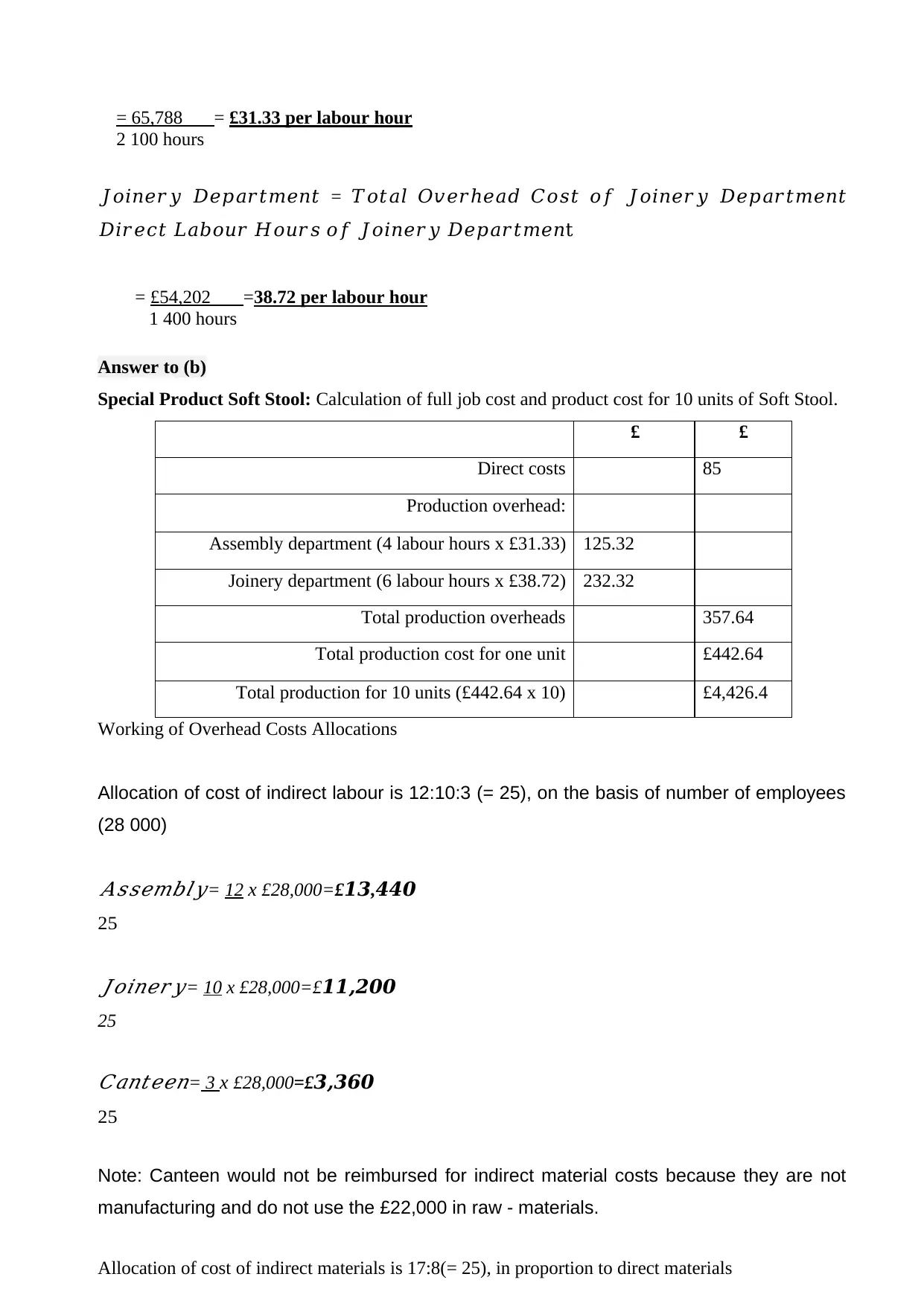
= 65,788 = £31.33 per labour hour
2 100 hours
𝐽𝑜𝑖𝑛𝑒𝑟𝑦 𝐷𝑒𝑝𝑎𝑟𝑡𝑚𝑒𝑛𝑡 = 𝑇𝑜𝑡𝑎𝑙 𝑂𝑣𝑒𝑟ℎ𝑒𝑎𝑑 𝐶𝑜𝑠𝑡 𝑜𝑓 𝐽𝑜𝑖𝑛𝑒𝑟𝑦 𝐷𝑒𝑝𝑎𝑟𝑡𝑚𝑒𝑛𝑡
𝐷𝑖𝑟𝑒𝑐𝑡 𝐿𝑎𝑏𝑜𝑢𝑟 𝐻𝑜𝑢𝑟𝑠 𝑜𝑓 𝐽𝑜𝑖𝑛𝑒𝑟𝑦 𝐷𝑒𝑝𝑎𝑟𝑡𝑚𝑒𝑛t
= £54,202 =38.72 per labour hour
1 400 hours
Answer to (b)
Special Product Soft Stool: Calculation of full job cost and product cost for 10 units of Soft Stool.
£ £
Direct costs 85
Production overhead:
Assembly department (4 labour hours x £31.33) 125.32
Joinery department (6 labour hours x £38.72) 232.32
Total production overheads 357.64
Total production cost for one unit £442.64
Total production for 10 units (£442.64 x 10) £4,426.4
Working of Overhead Costs Allocations
Allocation of cost of indirect labour is 12:10:3 (= 25), on the basis of number of employees
(28 000)
𝐴𝑠𝑠𝑒𝑚𝑏𝑙𝑦= 12 x £28,000=£13,440
25
𝐽𝑜𝑖𝑛𝑒𝑟𝑦= 10 x £28,000=£11,200
25
𝐶𝑎𝑛𝑡𝑒𝑒𝑛= 3 x £28,000=£3,360
25
Note: Canteen would not be reimbursed for indirect material costs because they are not
manufacturing and do not use the £22,000 in raw - materials.
Allocation of cost of indirect materials is 17:8(= 25), in proportion to direct materials
2 100 hours
𝐽𝑜𝑖𝑛𝑒𝑟𝑦 𝐷𝑒𝑝𝑎𝑟𝑡𝑚𝑒𝑛𝑡 = 𝑇𝑜𝑡𝑎𝑙 𝑂𝑣𝑒𝑟ℎ𝑒𝑎𝑑 𝐶𝑜𝑠𝑡 𝑜𝑓 𝐽𝑜𝑖𝑛𝑒𝑟𝑦 𝐷𝑒𝑝𝑎𝑟𝑡𝑚𝑒𝑛𝑡
𝐷𝑖𝑟𝑒𝑐𝑡 𝐿𝑎𝑏𝑜𝑢𝑟 𝐻𝑜𝑢𝑟𝑠 𝑜𝑓 𝐽𝑜𝑖𝑛𝑒𝑟𝑦 𝐷𝑒𝑝𝑎𝑟𝑡𝑚𝑒𝑛t
= £54,202 =38.72 per labour hour
1 400 hours
Answer to (b)
Special Product Soft Stool: Calculation of full job cost and product cost for 10 units of Soft Stool.
£ £
Direct costs 85
Production overhead:
Assembly department (4 labour hours x £31.33) 125.32
Joinery department (6 labour hours x £38.72) 232.32
Total production overheads 357.64
Total production cost for one unit £442.64
Total production for 10 units (£442.64 x 10) £4,426.4
Working of Overhead Costs Allocations
Allocation of cost of indirect labour is 12:10:3 (= 25), on the basis of number of employees
(28 000)
𝐴𝑠𝑠𝑒𝑚𝑏𝑙𝑦= 12 x £28,000=£13,440
25
𝐽𝑜𝑖𝑛𝑒𝑟𝑦= 10 x £28,000=£11,200
25
𝐶𝑎𝑛𝑡𝑒𝑒𝑛= 3 x £28,000=£3,360
25
Note: Canteen would not be reimbursed for indirect material costs because they are not
manufacturing and do not use the £22,000 in raw - materials.
Allocation of cost of indirect materials is 17:8(= 25), in proportion to direct materials
⊘ This is a preview!⊘
Do you want full access?
Subscribe today to unlock all pages.

Trusted by 1+ million students worldwide
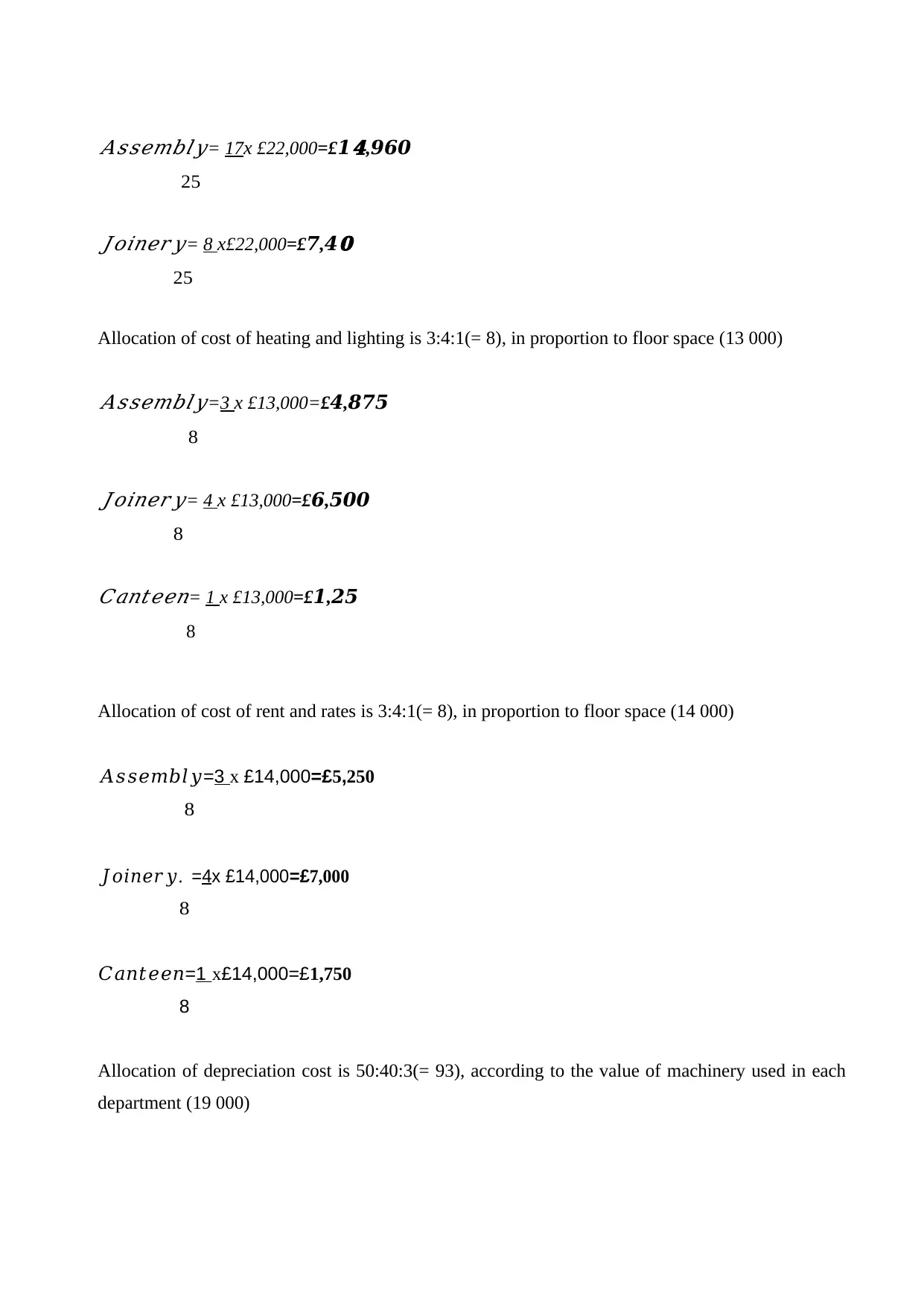
𝐴𝑠𝑠𝑒𝑚𝑏𝑙𝑦= 17x £22,000=£1
𝟒,960
25
𝐽𝑜𝑖𝑛𝑒𝑟𝑦= 8 x£22,000=£7,4
𝟎
25
Allocation of cost of heating and lighting is 3:4:1(= 8), in proportion to floor space (13 000)
𝐴𝑠𝑠𝑒𝑚𝑏𝑙𝑦=3 x £13,000=£4,875
8
𝐽𝑜𝑖𝑛𝑒𝑟𝑦= 4 x £13,000=£6,500
8𝐶𝑎𝑛𝑡𝑒𝑒𝑛= 1 x £13,000=£1,25
8
Allocation of cost of rent and rates is 3:4:1(= 8), in proportion to floor space (14 000)
𝐴𝑠𝑠𝑒𝑚𝑏𝑙𝑦=3 x £14,000=£5,250
8
𝐽𝑜𝑖𝑛𝑒𝑟𝑦. =4x £14,000=£7,000
8
𝐶𝑎𝑛𝑡𝑒𝑒𝑛=1 x£14,000=£1,750
8
Allocation of depreciation cost is 50:40:3(= 93), according to the value of machinery used in each
department (19 000)
𝟒,960
25
𝐽𝑜𝑖𝑛𝑒𝑟𝑦= 8 x£22,000=£7,4
𝟎
25
Allocation of cost of heating and lighting is 3:4:1(= 8), in proportion to floor space (13 000)
𝐴𝑠𝑠𝑒𝑚𝑏𝑙𝑦=3 x £13,000=£4,875
8
𝐽𝑜𝑖𝑛𝑒𝑟𝑦= 4 x £13,000=£6,500
8𝐶𝑎𝑛𝑡𝑒𝑒𝑛= 1 x £13,000=£1,25
8
Allocation of cost of rent and rates is 3:4:1(= 8), in proportion to floor space (14 000)
𝐴𝑠𝑠𝑒𝑚𝑏𝑙𝑦=3 x £14,000=£5,250
8
𝐽𝑜𝑖𝑛𝑒𝑟𝑦. =4x £14,000=£7,000
8
𝐶𝑎𝑛𝑡𝑒𝑒𝑛=1 x£14,000=£1,750
8
Allocation of depreciation cost is 50:40:3(= 93), according to the value of machinery used in each
department (19 000)
Paraphrase This Document
Need a fresh take? Get an instant paraphrase of this document with our AI Paraphraser
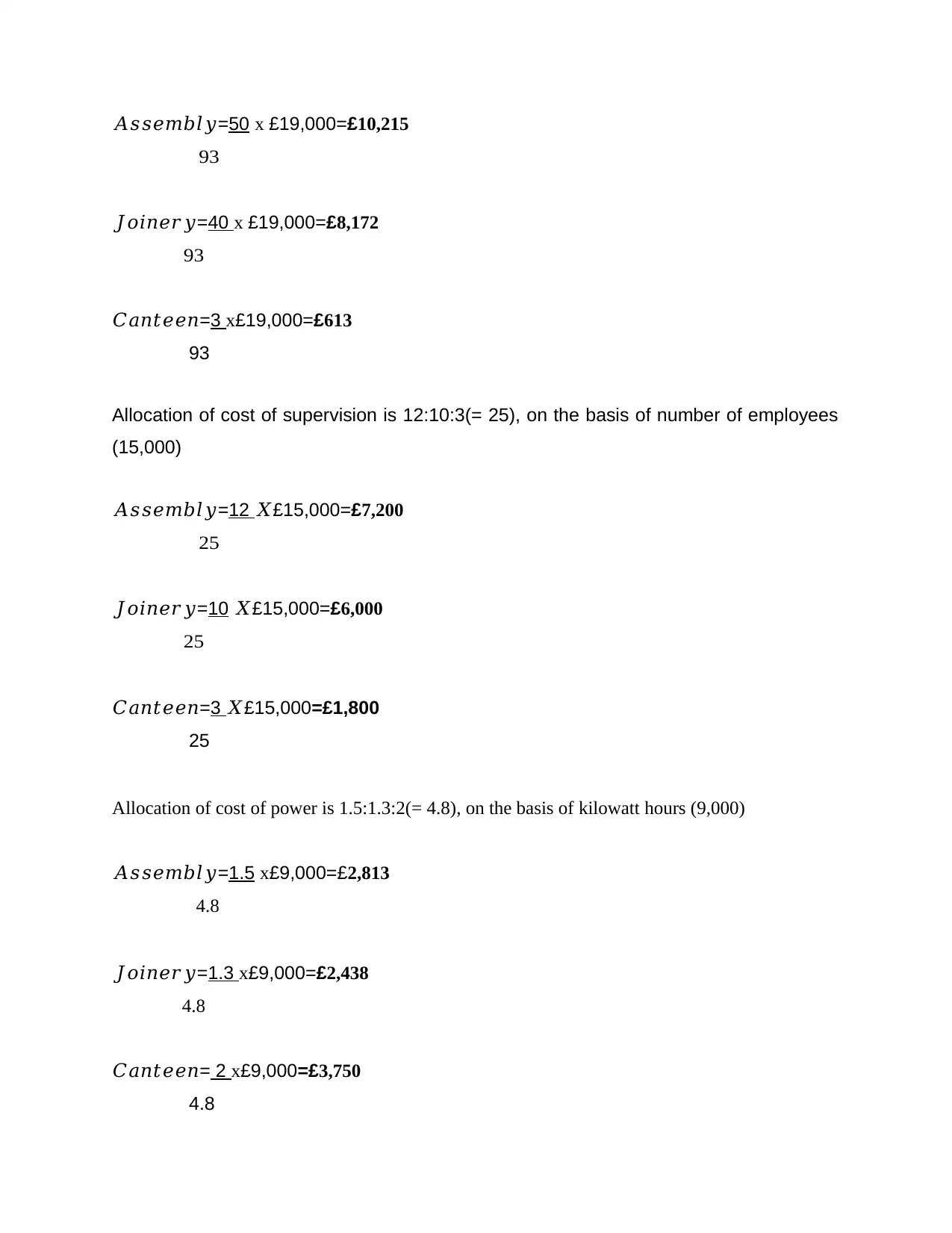
𝐴𝑠𝑠𝑒𝑚𝑏𝑙𝑦=50 x £19,000=£10,215
93
𝐽𝑜𝑖𝑛𝑒𝑟𝑦=40 x £19,000=£8,172
93
𝐶𝑎𝑛𝑡𝑒𝑒𝑛=3 x£19,000=£613
93
Allocation of cost of supervision is 12:10:3(= 25), on the basis of number of employees
(15,000)
𝐴𝑠𝑠𝑒𝑚𝑏𝑙𝑦=12 𝑋£15,000=£7,200
25
𝐽𝑜𝑖𝑛𝑒𝑟𝑦=10 𝑋£15,000=£6,000
25
𝐶𝑎𝑛𝑡𝑒𝑒𝑛=3 𝑋£15,000=£1,800
25
Allocation of cost of power is 1.5:1.3:2(= 4.8), on the basis of kilowatt hours (9,000)
𝐴𝑠𝑠𝑒𝑚𝑏𝑙𝑦=1.5 x£9,000=£2,813
4.8
𝐽𝑜𝑖𝑛𝑒𝑟𝑦=1.3 x£9,000=£2,438
4.8
𝐶𝑎𝑛𝑡𝑒𝑒𝑛= 2 x£9,000=£3,750
4.8
93
𝐽𝑜𝑖𝑛𝑒𝑟𝑦=40 x £19,000=£8,172
93
𝐶𝑎𝑛𝑡𝑒𝑒𝑛=3 x£19,000=£613
93
Allocation of cost of supervision is 12:10:3(= 25), on the basis of number of employees
(15,000)
𝐴𝑠𝑠𝑒𝑚𝑏𝑙𝑦=12 𝑋£15,000=£7,200
25
𝐽𝑜𝑖𝑛𝑒𝑟𝑦=10 𝑋£15,000=£6,000
25
𝐶𝑎𝑛𝑡𝑒𝑒𝑛=3 𝑋£15,000=£1,800
25
Allocation of cost of power is 1.5:1.3:2(= 4.8), on the basis of kilowatt hours (9,000)
𝐴𝑠𝑠𝑒𝑚𝑏𝑙𝑦=1.5 x£9,000=£2,813
4.8
𝐽𝑜𝑖𝑛𝑒𝑟𝑦=1.3 x£9,000=£2,438
4.8
𝐶𝑎𝑛𝑡𝑒𝑒𝑛= 2 x£9,000=£3,750
4.8
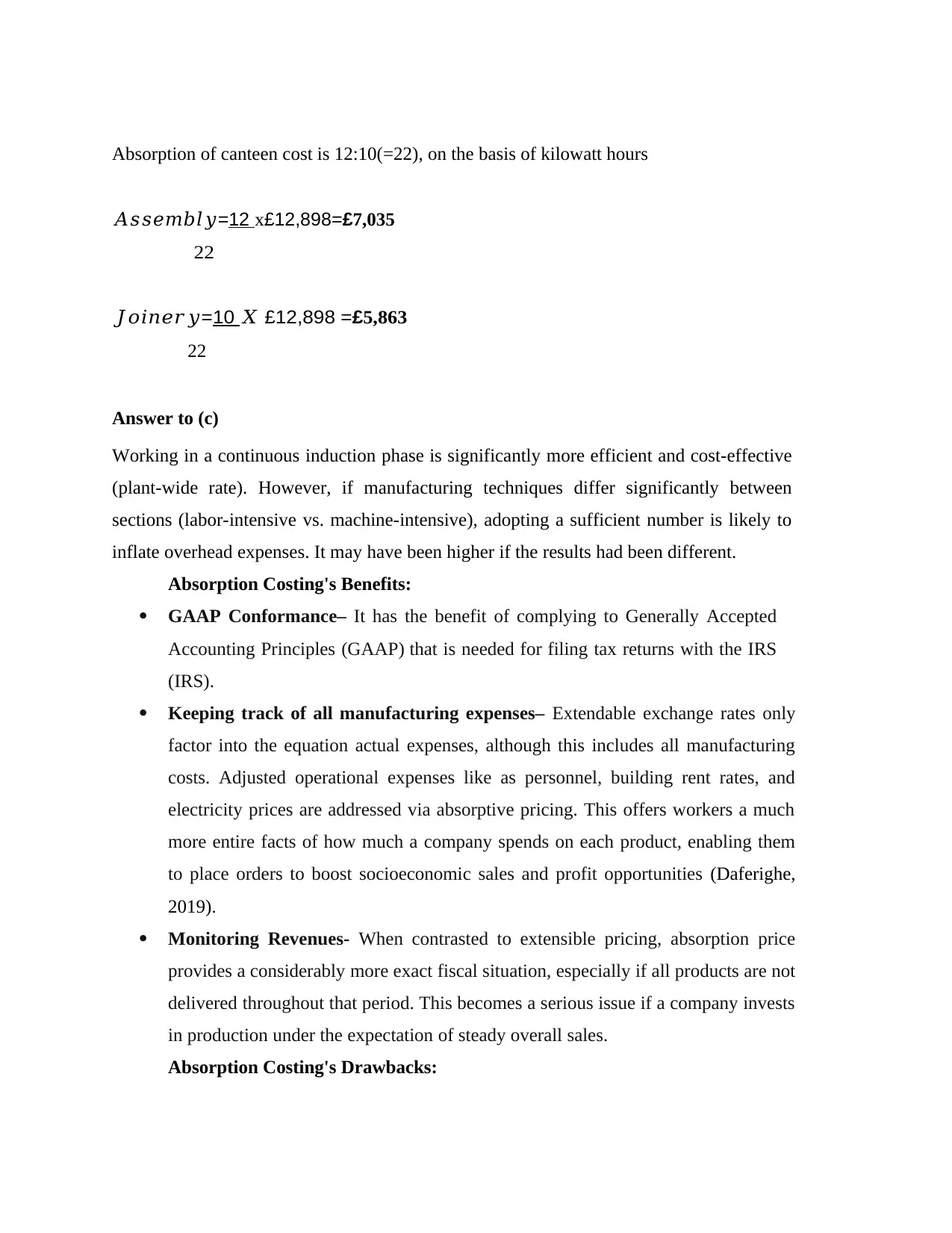
Absorption of canteen cost is 12:10(=22), on the basis of kilowatt hours
𝐴𝑠𝑠𝑒𝑚𝑏𝑙𝑦=12 x£12,898=£7,035
22
𝐽𝑜𝑖𝑛𝑒𝑟𝑦=10 𝑋 £12,898 =£5,863
22
Answer to (c)
Working in a continuous induction phase is significantly more efficient and cost-effective
(plant-wide rate). However, if manufacturing techniques differ significantly between
sections (labor-intensive vs. machine-intensive), adopting a sufficient number is likely to
inflate overhead expenses. It may have been higher if the results had been different.
Absorption Costing's Benefits:
GAAP Conformance– It has the benefit of complying to Generally Accepted
Accounting Principles (GAAP) that is needed for filing tax returns with the IRS
(IRS).
Keeping track of all manufacturing expenses– Extendable exchange rates only
factor into the equation actual expenses, although this includes all manufacturing
costs. Adjusted operational expenses like as personnel, building rent rates, and
electricity prices are addressed via absorptive pricing. This offers workers a much
more entire facts of how much a company spends on each product, enabling them
to place orders to boost socioeconomic sales and profit opportunities (Daferighe,
2019).
Monitoring Revenues- When contrasted to extensible pricing, absorption price
provides a considerably more exact fiscal situation, especially if all products are not
delivered throughout that period. This becomes a serious issue if a company invests
in production under the expectation of steady overall sales.
Absorption Costing's Drawbacks:
𝐴𝑠𝑠𝑒𝑚𝑏𝑙𝑦=12 x£12,898=£7,035
22
𝐽𝑜𝑖𝑛𝑒𝑟𝑦=10 𝑋 £12,898 =£5,863
22
Answer to (c)
Working in a continuous induction phase is significantly more efficient and cost-effective
(plant-wide rate). However, if manufacturing techniques differ significantly between
sections (labor-intensive vs. machine-intensive), adopting a sufficient number is likely to
inflate overhead expenses. It may have been higher if the results had been different.
Absorption Costing's Benefits:
GAAP Conformance– It has the benefit of complying to Generally Accepted
Accounting Principles (GAAP) that is needed for filing tax returns with the IRS
(IRS).
Keeping track of all manufacturing expenses– Extendable exchange rates only
factor into the equation actual expenses, although this includes all manufacturing
costs. Adjusted operational expenses like as personnel, building rent rates, and
electricity prices are addressed via absorptive pricing. This offers workers a much
more entire facts of how much a company spends on each product, enabling them
to place orders to boost socioeconomic sales and profit opportunities (Daferighe,
2019).
Monitoring Revenues- When contrasted to extensible pricing, absorption price
provides a considerably more exact fiscal situation, especially if all products are not
delivered throughout that period. This becomes a serious issue if a company invests
in production under the expectation of steady overall sales.
Absorption Costing's Drawbacks:
⊘ This is a preview!⊘
Do you want full access?
Subscribe today to unlock all pages.

Trusted by 1+ million students worldwide
1 out of 19
Related Documents
Your All-in-One AI-Powered Toolkit for Academic Success.
+13062052269
info@desklib.com
Available 24*7 on WhatsApp / Email
![[object Object]](/_next/static/media/star-bottom.7253800d.svg)
Unlock your academic potential
Copyright © 2020–2025 A2Z Services. All Rights Reserved. Developed and managed by ZUCOL.




